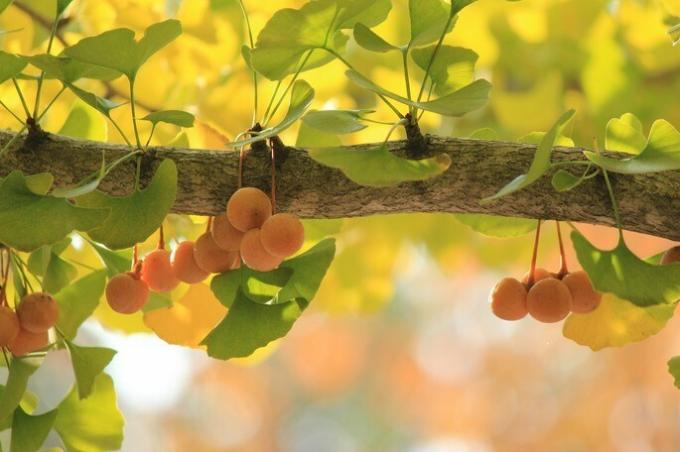Difference between angiosperms and gymnosperms
The angiosperms are plants with flowers, gymnosperms they are plants that do not have flowers. Both groups belong to the spermatophytes or seed plants. The seeds are the ovules (female cell) fertilized by the male cell contained in the pollen, which contains the embryo of the plant.
| Angiosperm | Gymnosperm | |
|---|---|---|
| Definition | Plants with flowers that produce seeds enclosed in a fruit. | Seed plants whose ovules and seeds do not form in closed cavities. |
| Coinage | German botanist Paul Hermann (1690) | Scottish botanist Robert Brown (1825) |
| Etymology | Latin Angiospermae, greek angeion (glass) + sperma (seed): seed inside a glass. | Greek gymnosperms, gymnos (naked) + sperma (seed): bare seed. |
| Emergence | It was Mesozoic (125 million years ago). | It was Paleozoic (390 million years ago). |
| Types |
|
|
| Examples | The apple tree, bean plants, strawberries, | Gingko biloba, Juniper sp., pines, cedars, cycads. |
What is angiosperm?

Angiosperms are seed-producing plants that possess flowers. The flower is a showy organ formed by groups of modified leaves. These modifications are in shape, color and size.
The seeds develop within the ovary, which grows and turns into fruit.
The word "angiosperm" derives from Latin Angiospermae, and this one from the combination of the Greek words angeion which means "glass, case, container" and sperma which means "seed, semen".
The German botanist Paul Hermann (1646-1695) is credited with using the word "angiosperm" to describe flowering plants.
Reproduction of angiosperms
Reproduction takes place in the flower. The sexual organs are surrounded by the corolla, the colored part of the flower, which is formed by the petals and surrounded by the calyx, a group of green leaves or sepals. In the case that the sepals and the petals do not differ, as in tulips, these are called tepals.
The male and female organs are located very close in most cases. The male organ o androecium It is formed by one or more stamens that consist of an elongated structure (filament), at the end of which is the anther, where pollen is produced.
The gynoecium, female organ, is formed by one or more pistils, which are found within the area surrounded by the stamens. Each pistil is made up of:
- an ovary, which contains the ovules, and
- a style, which supports the stigma, glandular body that receives pollen during fertilization.
Fertilization occurs when pollen reaches the stigma. There are angiosperm plants that produce hermaphroditic flowers, that is, they have both sex organs in the same flower; others instead form female flowers (they only have pistils) or male (they only have stamens). These plants are called monoecious. There are plants with female flowers and male flowers in different individuals, these are dioecious plants, for example, nettle Urtica dioica.
Pollination
Pollination of angiosperms is generally carried out by means of insects or through the wind. The plants entomophilous They have striking flowers with special shapes to attract insects. For example, orchids are flowers of various colors and shapes that are pollinated by insects.
In the plants anemophiles, the pollen is blown by the wind and deposited on the stigmas of other flowers. This is the case of corn and wheat plants.
Once on the stigmas, the pollen forms a pollen tube that passes through the stigma and reaches the ovary. Through the pollen tube, two sperm nuclei reach the ovule, one of the nuclei fuses with the nucleus of the ovocell. The embryo is formed from the fertilized egg cell, the first phase of the development of the new individual.
The second spermatic nucleus joins a second female nucleus, forming the endosperm, a reserve tissue that will be consumed by the embryo during its development. From this moment on, the embryo and endosperm will begin to grow. The corolla withers and falls, part of the ovule forms the coating of the seed and the ovary increases in size, forming the fruit, inside which are the seeds.
Types of angiosperms
Angiosperms are the most widely distributed plants on Earth. They are included in a single edge, the Anthophytas, which means that they originated from a common ancestor. Modern angiosperms are classified into monocots or dicots according to the structure of the leaves and embryos.
Basal angiosperms
Basal angiosperms are a group of plants that exhibit mono- and dicotyledonous characteristics. Within this group are magnolias, laurel, cinnamon tree, water lilies or nymphs, avocado or avocado and peppers. An example of a basal angiosperm is the nymph Nymphaea mexicana.
Monocots
This group includes herbs, onions, palms, orchids, and grasses. They are characterized by leaves with parallel veins, adventitious roots, and flowers in arrangements of three or multiples of three petals.
Dicotyledons
Dicots make up two-thirds of the angiosperms on the planet. They are characterized by the presence of two cotyledons in the embryo, leaves with web-shaped veins and a main root. Within this group we get tomato plants, potatoes, beans, and mango, apple and peach trees, among others.
Evolution of angiosperms
The appearance of angiosperms is located in the Mesozoic era, in the Cretaceous period, about 125 million years ago. Genomic and paleobotanical evidence suggests that angiosperms did not evolve from gymnosperms, but in parallel.
It may also interest you Differences between monocots and dicots.
What is gymnosperm?

Gymnosperms are seed-producing plants that do not possess flowers. In gymnosperms, the flowers are replaced by cones, which lack ovaries. The ovules are naked, as are the seeds that form from them (they are not found inside a fruit).
Etymologically the word gymnosperm derives from the Greek gymnosperms, which means naked seed, for gymnos "naked" and sperma "seed, semen".
This group of plants does not use insects for pollination, but uses only the wind (anemophiles).
Gymnosperm characteristics
- Plants with seeds adapted to life on earth.
- Autotrophic: they are photosynthetic organisms.
- They present a vascular system, which includes xylem, phloem and roots, through which water and nutrients are transported.
- The seeds develop into cone or pine cone scales.
- They produce male and female spores.
- They are monoecious, the same plant has both male and female structures.
Reproduction of gymnosperms
Gymnosperms are sporophytes, plants with two copies of their genetic material capable of producing spores. They are also heterospores, that is, they have male and female gametophytes that develop from spores produced by separate cones.
The male cone produces microspores that develop into pollen grains. The female cone produces megaspores that develop into ovules.
The wind releases the pollen grains that settle on the female cones. In gymnosperm plants, fertilization takes a long time due to the slowness with which the pollen forms the tube through which it reaches the female gamete.
Types of gymnosperms
Gymnosperms inhabit many ecosystems, especially in temperate and cold regions since they adapted to this type of climate. They are classified into four main phyla: Coniferophyta, Cycadophyta, Gingkophyta Y Gnetophyta.
Conifers
Conifers are the dominant group of gymnosperms. This includes pine, fir and juniper trees. In this type of plants, the sexual organs are protected by small scales, gathered in groups of different shapes (cones or cones).
The female cones are larger and are formed on the short branches. The male cones form each spring in clusters located at the ends of the longest branches, and this is where the pollen comes from.
Ginkgoales

Of the ginkgoales, there is currently only the Gingko biloba. Unlike other gymnosperms, this tree produces male and female organs in different plants.
Cicadas
Cycads thrive in tropical and subtropical climates; they are often mistaken for palm trees because of the shapes of their leaves. However, they have large cones that can be pollinated by insects.
Gymnosperm evolution
Fossil records show that the first gymnosperms originated from ferns, probably in the Devonian period (Paleozoic era) about 390 million years ago. The possibility of producing seeds allowed them to adapt to dry conditions.
Ginkgoales were the first gymnosperms to appear in the Jurassic period. In this period the cicadas, palm-like trees, also proliferated.
It may interest you to see Fruit and vegetable.



